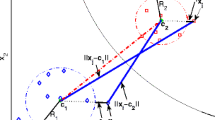Abstract
Support vector machines (SVMs), initially proposed for two-class classification problems, have been very successful in pattern recognition problems. For multi-class classification problems, the standard hyperplane-based SVMs are made by constructing and combining several maximal-margin hyperplanes, and each class of data is confined into a certain area constructed by those hyperplanes. Instead of using hyperplanes, hyperspheres that tightly enclosed the data of each class can be used. Since the class-specific hyperspheres are constructed for each class separately, the spherical-structured SVMs can be used to deal with the multi-class classification problem easily. In addition, the center and radius of the class-specific hypersphere characterize the distribution of examples from that class, and may be useful for dealing with imbalance problems. In this paper, we incorporate the concept of maximal margin into the spherical-structured SVMs. Besides, the proposed approach has the advantage of using a new parameter on controlling the number of support vectors. Experimental results show that the proposed method performs well on both artificial and benchmark datasets.
Similar content being viewed by others
References
Blake CL, Merz CJ (1998) UCI repository of machine learning databases. Dept Inform Comput Sci, Univ California, Irvine, CA (online). Available: http://kdd.ics.uci.edu/
Bottou L, Cortes C, Denker J, Drucker H, Guyon I, Jackel L, LeCun Y, Muller U, Sackinger E, Simard P, Vapnik V (1994) Comparison of classifier methods: a case study in handwriting digit recognition. In: Proceediongs of the international conference on pattern recognition, pp 77–87
Chang CC, Lin CJ (2001) LIBSVM: a library for support vector machines (online). Available: http://www.csie.ntu.edu.tw/~cjlin/libsvm/
Chen CC (2005) Computational mathematics. Univ Tsing Hua, Institute of Information Systems & Applications. Data available at http://www.cs.nthu.edu.tw/~cchen/ISA5305/isa5305.html
Chiang J-H, Hao P-Y (2003) A new kernel-based fuzzy clustering approach: support vector clustering with cell growing. IEEE Trans Fuzzy Syst 11:518–527
Cooper PW (1962) The hypersphere in pattern recognition. Inf Control 5:324–346
Cooper PW (1966) Note on adaptive hypersphere decision boundary. IEEE Trans Electron Comput 948–949
Cortes C, Vapnik V (1995) Support-vector network. Mach Learn 20:273–297
Crammer K, Singer Y (2000) On the ability and design of output codes for multiclass problems. In: Computational learning theory, pp 35–46
Fan RE, Chen PH, Lin CJ (2005) Working set selection using second order information for training support vector machines. J Mach Learn Res 6:1889–1918
Fukunaga K (1990) Introduction to statistical pattern recognition, 2nd edn. Academic Press, New York
Hsu CW, Lin CJ (2002) A comparison of methods for multiclass support vector machines. IEEE Trans Neural Netw 13:415–425
Kreßel U (1999) Pairwise classification and support vector machines. In: Schölkopf, B, Burges CJC, Smola AJ (eds) Advances in kernel methods—support vector learning. MIT Press, Cambridge, pp 255–268
M Manevitz L, Yousef M (2001) One-class SVMs for document classification. J Mach Learn Res 2:139–154
Marchand M, Shawe-Taylor J (2002) The set covering machine. J Mach Learn Res 3:723–746
Michie D, Spiegelhalter DJ, Taylor CC (1994) Machine learning, neural and statistical classification. Ellis Horwood, Chichester Available: http://www.maths.leeds.ac.uk/~charles/statlog/
Mitchell T (1997) Machine Learning. McGraw-Hill, New York Data available at http://www.cs.cmu.edu/afs/cs.cmu.edu/user/mitchell/ftp/faces.html
Mukherjee S, Vapnik V (1999) Multivariate density estimation: A support vector machine approach. Technical Report: AI Memo No 1653, MIT AI Lab
Platt JC (1999) Fast training of support vector machines using sequential minimal optimization. In: Schölkopf, B, Burges CJC, Smola AJ (eds) Advances in kernel methods—support vector learning. MIT Press, Cambridge, pp 185–208
Platt JC, Cristianini N, Shawe-Taylor J (2000) Large margin DAG’s for multiclass classification. In: Advances in neural information processing systems, vol 12. MIT Press, Cambridge, pp 547–553
Reilly DL, Cooper LN, Elbaum C (1982) A neural model for category learning. Biol Cybern 45:35–41
Schölkopf B, Burges C, Vapnik V (1995) Extracting support data for a given task. In: Proceedings of first international conference on knowledge discovery and data mining, pp 252–257
Schölkopf B, Platt JC, Shawe-Taylor J, Smola AJ, Williamson RC (2001) Estimating the support of a high-dimensional distribution. Neural Comput 13:1443–1471
Tax D, Duin R (1999) Support vector domain description. Pattern Recognit Lett 20:11–13
Tax D, Duin R (2004) Support vector data description. Mach Learn 54:45–66
Vapnik V (1998) Statistical learning theory. Wiley, New York
Wang J, Neskovic P, Cooper LN (2005) Pattern classification via single spheres. In: Lecture notes in artificial intelligence, vol 3735, pp 241–252
Weston J, Watkins C (1999) Multi-class Support machines. In: Verleysen M (ed) Proceedings of ESANN99, Brussels
Wu Q, Shen X, Li Y, Xu G, Yan W, Dong G, Yang Q (2005) Classifying the multiplicity of the EEG source models using sphere-shaped support vector machines. IEEE Trans Magn 41:1912–1915
Zhu ML, Chen SF, Liu XD (2003) Sphere-structured support vector machines for multi-class pattern recognition. In: Lecture notes in computer science, vol 2639, pp 589–593
Author information
Authors and Affiliations
Corresponding author
Rights and permissions
About this article
Cite this article
Hao, PY., Chiang, JH. & Lin, YH. A new maximal-margin spherical-structured multi-class support vector machine. Appl Intell 30, 98–111 (2009). https://doi.org/10.1007/s10489-007-0101-z
Received:
Accepted:
Published:
Issue Date:
DOI: https://doi.org/10.1007/s10489-007-0101-z




